Cover image: Grim Flayer by Mathias Kollros
In the roster of Magic mechanics, we’ve had more failures than successes. That’s to be expected when you have to churn out the sheer number they do. Fateful Hour, Ripple, Sweep, Radiance, Amplify—at best, they’re forgotten, at worst, they’re remembered for the games they’ve lost you. The golden mechanics of Kicker and Cycling are the top of the heap, and in between are the most interesting: those mechanics that are just waiting for the right set of cards to be printed or revisited in a future block to become tournament staples. Who knows—the day Banding returns could be just over the horizon in Dominaria United.
The most tantalizingly fertile mechanic for me, though, is a relatively recent one that got a boost in Modern Horizons: Delirium.
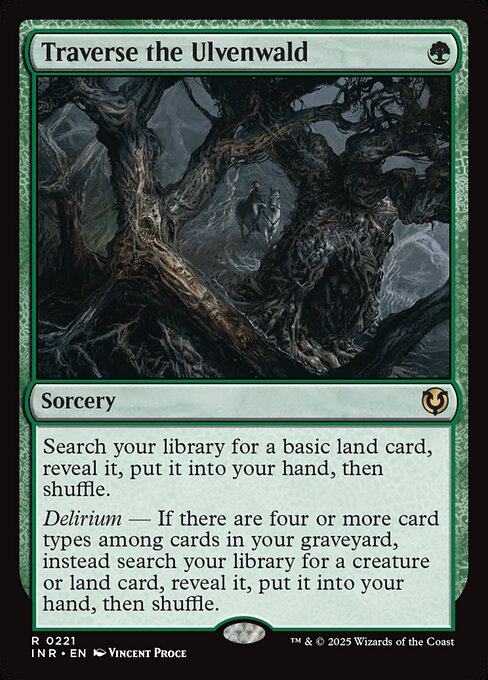
A brief overview: Delirium was first printed in Shadows over Innistrad, where it was designed to mimic a society being driven mad by eldritch forces, culminating in the emergence of Emrakul on the plane of Innistrad. It was mostly a Limited ability, calibrated to offer benefits to those who milled or discarded or sacrificed their resources, although Emrakul, the Promised End dominated Standard, with players warping their deck lists a bit to prioritize a panoply of card types.
All around, Delirium played very much like Odyssey Block’s Threshold—giving your outclassed creatures and spells lategame benefits once you met the qualifications. Cards like Deathcap Cultivator, once they’d served their usefulness as mana accelerant, could trade up with a larger creature once you’d binned four card types. Early beaters like Topplegeist and Gnarlwood Dryad scaled up in power as the game went on. I love this sort of mechanic, personally, as it organically energizes itself as the game continues and can be kickstarted if you build around it.
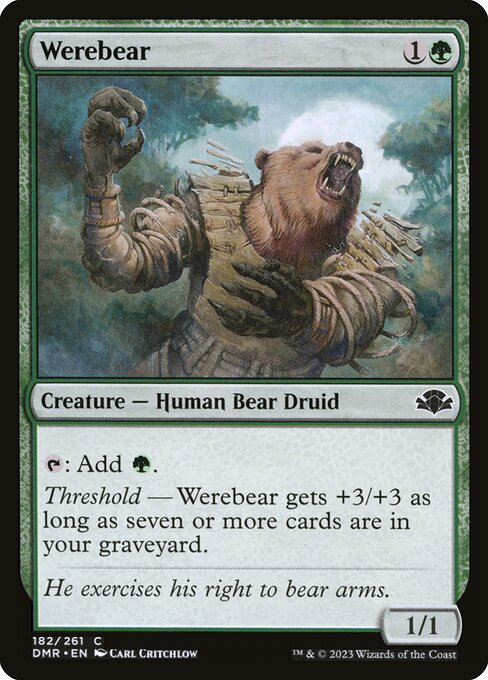
Threshold was my first introduction to this style of mechanic—a refreshing change from the Cumulative Upkeep and taxing mechanics that defined early Magic. With the release of fetchlands and Dredge and more potent self-mill cards, it became trivial to achieve Threshold, so Wizards had to move away from the simple “fill the ‘yard for significant benefit” model in Shadows over Innistrad with Delirium.
Unlike Threshold, Delirium counted not the number of cards, but the number of card types in your graveyard. This is basic stuff, but just to fully explain: the card types are artifact, creature, enchantment, land, instant, planeswalker, sorcery, and tribal. Cards with two types, like Artifact Creatures or Enchantment Creatures, count double for the purposes of Delirium and are thus particularly attractive. For example, a graveyard that’s completely empty save for Bitterblossom (Tribal Enchantment) and Walking Ballista (Artifact Creature) would count as four types for Delirium. Delirium isn’t as trivial to achieve as Threshold, but—especially in older formats—it’s pretty easy. If your deck is built to maximize Tarmogoyf, which most Modern decks were at one point, you’re already heading towards Delirium.
Like Threshold, Delirium is an ability word, meaning Wizards of the Coast retains the right to redesign it as some point. That may be unlikely, but it is worth keeping in mind. You can see this in how Threshold and Delirium cards (for the most part, depending on space constraints) spell out directly what the threshold for each is. If Threshold were a mechanic, it would be continuously linked to having seven cards in your graveyard, thus wouldn’t require spelling it out on the card. Krosan Beast would just read “Threshold—Krosan Beast gets +7/+7.”
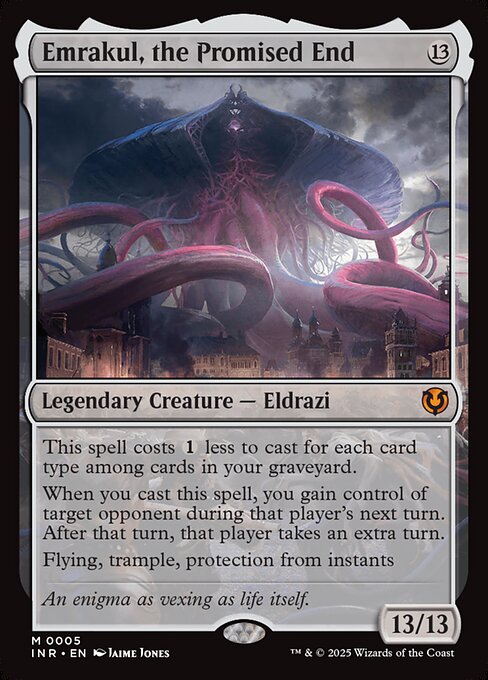
Theoretically, Wizards could bring Threshold back as “if you have twelve or more cards in your graveyard” or even “if you have seven or more cards in your hand”; but they haven’t done so in twenty years, so I don’t think it’s likely. I also don’t see them changing Delirium, since it just returned last year in Moderns Horizons 2.
Early Pioneer players had success with Golgari and Sultai Delirium decks, but mostly because those decks got to play Thoughtseize, Uro, and Oko. Delirium was originally exciting, since it harkens back to tournament staple Tarmogoyf and the powerful Threshold cards from Odyssey. It seemed like it would play well with Dredge, but it just never got there. Or more accurately: it hasn’t gotten there yet.

As someone who played back in the Odyssey days and didn’t have a lot of discretionary cash for cards, I have an abiding fondness for Blue-Green Madness, a beautiful deck that was almost completely commons and uncommons. Discarding cards to feed your Wild Mongrel—and still getting to cast them, and potentially exploit them later for Threshold/Flashback shenanigans—felt incredible. Once Dredge came out a couple of years later—and John Rizzo exploited the mechanic for Friggorid, it was over for me: I was a graveyard player in every format. From Goryo’s Vengeance in Modern to Ichorid in ancient Extended to Standard self-mill, and Pioneer is no exception.
I’ve been experimenting with two forms of Delirium decks in Pioneer: Sultai and Jund, and both have promise.
Jund Delirium
| Creatures (16) 2 Stonecoil Serpent 3 Scavenging Ooze 4 Grim Flayer 2 Murderous Rider 2 Courser of Kruphix 2 Graveyard Trespasser 1 Questing Beast Planeswalkers (3) 2 Liliana, the Last Hope 1 Nissa, Voice of Zendikar Spells (17) 4 Thoughtseize 2 Fatal Push 2 Collective Brutality 3 Kolaghan's Command 4 Fable of the Mirror-Breaker 2 Ratchet Bomb | Lands (24) 4 Fabled Passage 2 Ziatora's Proving Ground 4 Blooming Marsh 1 Overgrown Tomb 1 Blood Crypt 3 Blightstep Pathway 2 Slitherbore Pathway 1 Cragcrown Pathway 3 Swamp 2 Forest 1 Mountain |
The advantages of the Jund build are simply this: you get to run Fable of the Mirror-Breaker, one of the absolutely best cards in Pioneer, to supplement your Delirium plan. While Fable is generically a top-tier card, it really sings in this deck: the Goblin token helps smooth your mana, which can be a bit tricky without Blackcleave Cliffs. The second stage lets you loot away unneeded cards to hit Delirium on turn four, and a flipped Saga can put pressure on the opponent with a copy of Grim Flayer or Graveyard Trespasser. Don’t forget that exiling and then returning the Saga powers up Fatal Push.
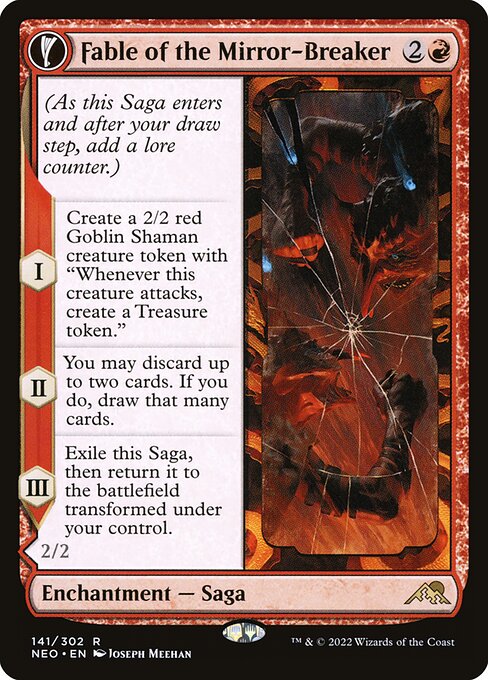
Your only other Red card, Kolaghan’s Command, is flexible interaction with a hidden mode—discarding a card mid-combat to turn on Delirium. Obviously, that’s less than optimal, but you’d be amazed how often it comes up—counteracting Wild Slash on your Grim Flayer and shocking something of your own can shift the flow of the game.
That’s just one iteration of the deck, though. While Fable of the Mirror-Breaker is a staple of staples, there’s another recent card that’s coming into its own, and does so best in a deck that’s capable of exploiting the graveyard: Ledger Shredder. We lose Fable, which hurts, and Command, but we pick up one of the better assets for our deck: a quasi-Goyf who interlocks perfectly with our Flayer plan.
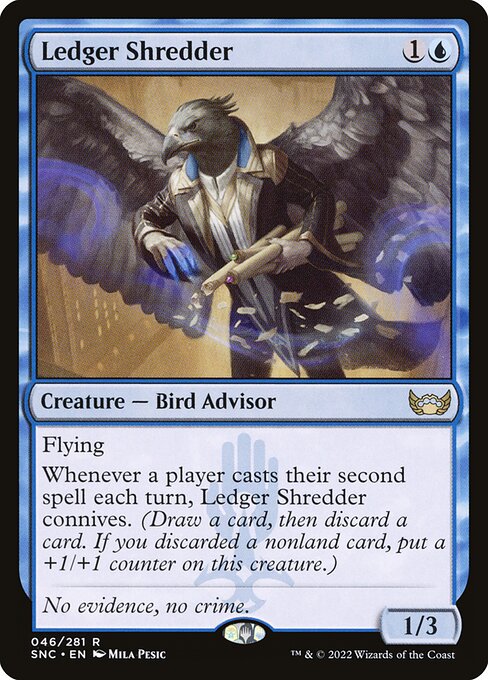
Here’s the list I’ve been playing:
Sultai Delirium
| Creatures (18) 2 Stonecoil Serpent 4 Ledger Shredder 3 Scavenging Ooze 2 Dryad of the Ilysian Grove 4 Grim Flayer 2 Graveyard Trespasser 1 Thassa, God of the Sea Planeswalkers (3) 2 Liliana, the Last Hope 1 Kaito Shizuki Spells (16) 4 Thoughtseize 4 Fatal Push 2 Drown in the Loch 2 Collective Brutality 2 The Meathook Massacre 2 Ratchet Bomb | Lands (23) 4 Fabled Passage 2 Zagoth Triome 4 Blooming Marsh 3 Botanical Sanctum 2 Watery Grave 1 Breeding Pool 4 Barkchannel Pathway 3 Clearwater Pathway |
The Sultai version is faster and lower to the ground to better exploit Ledger Shredder; otherwise, it’s quite close to the Jund version, which has made it easy to swap out on the fly. I prefer the Jund version just a touch. That’s probably my own insecurities, as it just feels better to have a Command in hand and not be susceptible to format enforcer Mystic Dispute, but I will note how impressed I am with Kaito Shizuki.
Whichever works best for you, though, it’s a good time to be a Golgari+ graveyard player. Right now, Pioneer—and even Explorer!—have two of the best Delirium enablers in Ledger Shredder and Fable of the Mirror-Breaker. Fable lets you loot whatever turns on Delirium and replace those cards, while Ledger Shredder churns through your deck in combination with cheap interaction. The Meathook Massacre buys you time against aggro decks and is situational enough that it can be an easy discard, while Questing Beast is a Lili-killer and surprise game-closer.
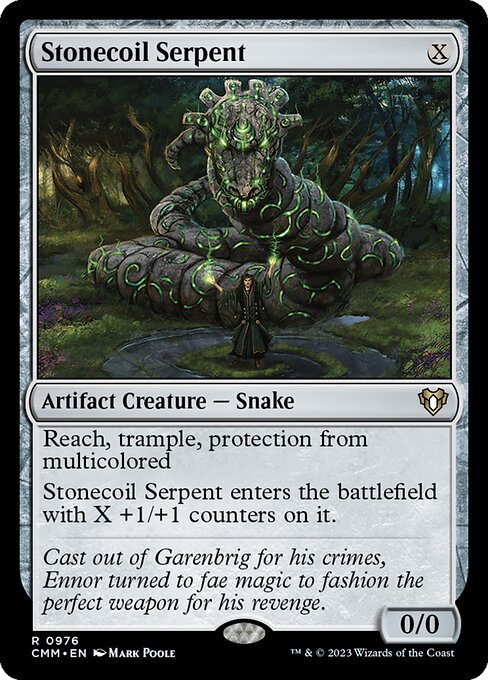
What are we missing that we can expect to see in the near future? Right now, Pioneer has a serious dearth of playable artifacts to turn on Delirium. Stonecoil Serpent is decent and scalable through the game, and can actually close games out against U/W control and various Golgari decks—Abrupt Decay and Assassin’s Trophy fare poorly against the Serpent. But it’s no Walking Ballista. Nor is Hangarback Walker. Ratchet Bomb turns a token board into a hecatomb and is a decent quasi-Deed, but it could use backup.
With any luck, the Brothers’ War will slip up and give us a Bauble of some stripe or a near-broken Artifact Creature to boost our artifact count. I’ve flirted with Hope of Ghirapur, but I have limits. I’m trying to keep my expectations low, but with a trip back to Dominaria and a time back in time to the Urza/Mishra artificers’ war, I do have hopes for better Enchantments and Artifacts than we have access to at the moment.
More than anything, this deck feels like a solid base for future development, the Pioneer equivalent of fair-but-dependable Modern Jund. Grim Flayer has never lived up to its potential—too small for Modern, too finicky for Pioneer—but we’re getting closer. The feeling of mid-combat Commanding yourself to discard an extraneous Courser and sniping an X/2 and getting in for the Surveil 3 and extra damage is enough to hook anyone, particularly if you have the predilection for graveyard grubbing that I do, and apparently always will. There are worse places to be than a graveyard. One way or the other, we all end up there eventually, and, despite what Andrew Marvell would have you believe, it’s a playground.
A lifelong resident of the Carolinas and a graduate of the University of North Carolina, Rob has played Magic since he picked a Darkling Stalker up off the soccer field at summer camp. He works for nonprofits as an educational strategies developer and, in his off-hours, enjoys writing fiction, playing games, and exploring new beers.

